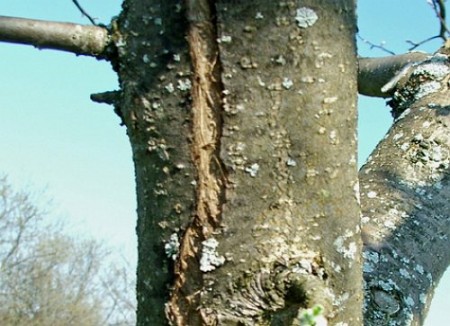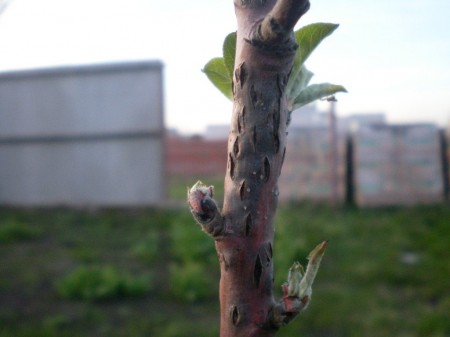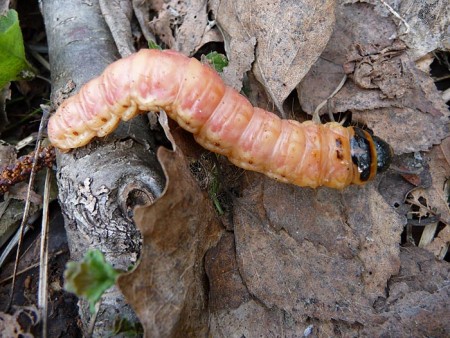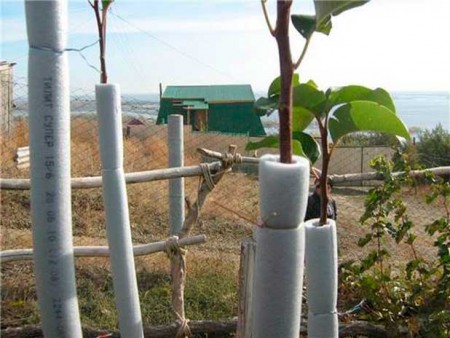The fact that the bark cracks even on young fruit trees is most often to blame for:
- Severe frosts in winter.
- Unbalanced diet.
- Stem pests.
Bark on trees can burst due to frost
It is primarily the southern varieties that are not adapted to our climate that suffer from frost.Do not plant southern varieties (Rostov, Krasnodar, Stavropol) that are not zoned in your zone in your dacha, so as not to have problems later. And if you do plant them, use the highest agricultural techniques for them: balanced nutrition, regular watering, proper pruning, preparation for overwintering (mulching, protecting the root system, whitewashing the trunks and tying light material on the trunks of young trees, pre-winter watering).
Nutritional imbalance can cause bark cracking
Agrotechnical anomalies were added to the weather anomalies. The main thing is nutritional imbalance. Many amateur gardeners overestimate the doses of nitrogen fertilizers and do not comply with the timing of their application. Only urea (urea) is considered nitrogen. But they continue to add so-called green fertilizers (infusion of grass) or diluted bird droppings, rich in nitrogen, to the soil throughout the summer.
Such nitrogen-containing liquid fertilizers are very useful for trees in the spring: April-May, early June. In July, trees better absorb nutrients through leaves and it is better to use foliar feeding. In the future, nitrogen fertilizing must be reduced.
In summer and early autumn, complex fertilizers with a minimum nitrogen content (no more than 5 percent) are needed. The main components of fertilizing at this time are phosphorus (superphosphate) and potassium (sulfate) with the addition of microelements that the plant lacks.
Unbalanced nutrition negatively affects the ripening of wood and core. They are the ones who most often suffer in the frosty winter. As a result, the conducting vascular system is disrupted, and the tree does not receive the necessary nutrition and, as a result, cracks on tree trunks.
Stem pests
Stem pests pose a great danger to our trees:
- fruit sapwood (apple and plum bark beetle)
- wrinkled sapwood
- western bark beetle
- woodworm
- glassware
- rodents.
Sapwood beetles
In May, sapwood beetles gnaw round holes in the bark, females make oblong passages under the bark, and their larvae gnaw out transverse passages. As a result, sap flow is disrupted and the tree becomes sick. In trees heavily affected by sapwood, not only the bark cracks, but entire branches dry out.
Control measures. Plants can be protected from sapwood by good care, which promotes better growth and development of the tree. Immediately after flowering, spray with fufanon or kemifos, thoroughly moistening the branches and trunks with an insecticide solution. Repeated treatment - after 16-18 days.
Woodworm butterflies
Carpenter moth butterflies lay eggs on tree branches and trunks from June to September. The hatched caterpillars bite into the tops of shoots and then under the bark, feeding on the wood of branches and trunks for two years. Damaged shoots dry out already in September-October. By gnawing holes under the bark and in the wood, the corrosive woodworm disrupts the sap flow of the tree. Damaged plants get sick and die.
Control measures. Organophosphorus preparations (fufanon, kemifos) are recommended against woodworm in July-August at intervals of 12-14 days. The solution should be used to moisten not only the leaves, but also the bark of branches and the trunks of damaged trees. At the end of August-September, damaged, withering shoots are cut and burned. They contain woodworm caterpillars.
The proliferation of stem pests is explained by the fact that not all gardeners carefully care for the trunks and skeletal branches of old trees.In the fall, it is necessary to clear the lagging bark for litter and burn it, coat the trunks with a mash of clay and mullein, whiten them with a mixture of fluff lime (2 kg) and copper sulfate (100 g per 10 liters of water).
Hot, dry summers promote the proliferation of fruit mites in orchards. They also cause great harm by sucking the juice from the buds and leaves. Damaged leaves do not develop, and branch growth stops. The productivity and winter hardiness of trees is reduced. Ticks accumulate especially in thickened crowns, on annual shoots and fatty shoots. 4-7 generations produce ticks over the summer.
How to fight ticks. You need to start fighting the mite in the spring, before the buds open: spray with N30 (500 g per 10 liters of water), thoroughly moisten thin and thick branches, as well as tree trunks. In summer, colloidal sulfur, the drug thiovit-jet, fufanon, actellik are used.
In June, trapping belts are placed on the trunks and skeletal branches (in November they are removed and burned). A large number of female ticks accumulate under the hunting belts. In this fairly simple way you can protect trees from pests.
Plum, cherry plum, and sloe are damaged by the plum gall mite. After the end of plum flowering, mites emerge from their wintering areas (at the base of annual shoots), attach themselves to young shoots, forming galls 1-2 mm in size. Damaged shoots do not produce growth, leaves lag behind in development, branches dry out, trees do not bear fruit.
A lime-sulfur decoction is effective against these mites immediately after flowering and again after 10 days, as well as spraying with colloidal sulfur or thiovit-jet, karbofos or fufanon at the same time as the lime-sulfur decoction.
In autumn it is necessary to protect the trunks from rodents.Use protective harnesses (at least old tights), poisoned baits, and repellents. In winter, trample the snow in tree trunk circles and sprinkle them with sawdust soaked in creolin.
And remember: the bark on fruit trees cracks due to poor care or lack thereof.





 (2 ratings, average: 4,50 out of 5)
(2 ratings, average: 4,50 out of 5) CUCUMBERS NEVER GET SICK, I'VE BEEN USING ONLY THIS FOR 40 YEARS! I SHARE A SECRET WITH YOU, CUCUMBERS ARE LIKE THE PICTURE!
CUCUMBERS NEVER GET SICK, I'VE BEEN USING ONLY THIS FOR 40 YEARS! I SHARE A SECRET WITH YOU, CUCUMBERS ARE LIKE THE PICTURE! You can dig a bucket of potatoes from each bush. Do you think these are fairy tales? Watch the video
You can dig a bucket of potatoes from each bush. Do you think these are fairy tales? Watch the video
 How our fellow gardeners work in Korea. There is a lot to learn and just fun to watch.
How our fellow gardeners work in Korea. There is a lot to learn and just fun to watch. Eye trainer. The author claims that with daily viewing, vision is restored. They don't charge money for views.
Eye trainer. The author claims that with daily viewing, vision is restored. They don't charge money for views. A 3-ingredient cake recipe in 30 minutes is better than Napoleon. Simple and very tasty.
A 3-ingredient cake recipe in 30 minutes is better than Napoleon. Simple and very tasty. Therapeutic exercises for cervical osteochondrosis. A complete set of exercises.
Therapeutic exercises for cervical osteochondrosis. A complete set of exercises. Which indoor plants match your zodiac sign?
Which indoor plants match your zodiac sign? What about them? Excursion to German dachas.
What about them? Excursion to German dachas.